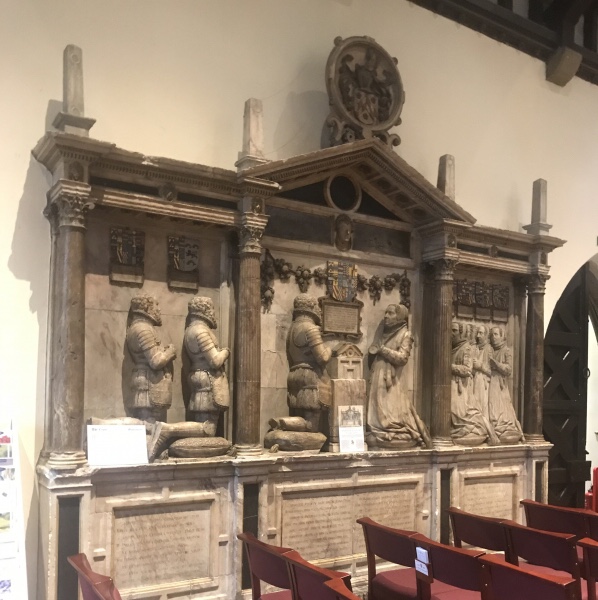The Church of St Edward the Confessor (in full, the Parish Church of the Blessed Virgin Mary and St Edward the Confessor[1]) is a place of worship in Romford, in the London Borough of Havering. It is an Anglican church in the Diocese of Chelmsford. The building, dating from 1849–1850, replaced an earlier church that was demolished in the mid-19th century; there has been a religious building on the site since the end of the 14th century. The current church was completed to a Victorian Gothic design by the English architect John Johnson,[2] and was designated a Grade II* listed building by English Heritage in 1952.
History
Church of 1410
Romford’s earliest known place of worship was a small chapel, dedicated to Saint Andrew (after its then parish church, the local priory of St Andrew, Hornchurch), in Old Church, an area of the borough that still exists. The chapel, established in 1177, was built near to the River Rom, from which Romford takes its name. The chapel existed into the late 14th century, but fell into ruin and was demolished. Oldchurch, which is inside Romford’s ring road, takes its name from the Old Church of 1177.[1]
A replacement church was built on the site of the present building towards the end of the 14th century, and completed in 1410. The grounds were consecrated by Henry Chichele, Bishop of St David’s, on 23 March that year, and dedicated to the Virgin Mary and St Edward the Confessor. The church had a chancelPart of a church containing the altar, used by the officiating clergy., a naveCentral part of a church, used by the laiety., an extended north aisle – which was longer than its predecessor by 28 feet (9 m) and wider by 14 feet (4 m) – and featured a brick tower housing a ring of five bells. A gallery was later built within the western part of the building, in which a charity for orphaned children was later founded.[1]
By 1710 the orphanage had become the St Edward’s School and moved to a separate building in Romford’s Market Place in 1728. Almost 30 years later a replacement weight-driven clock was installed, and three bells were added to the peal. The building remained in use until 1844 when work on a new church to the east of the Market Place (now the war memorial in Main Road) was started.[1]
The new building in Main Road was designed by Edward Blore as a chapel, only. Halfway through construction the planners decided to relocate the town’s church back to Market Place.[3] The last services were held at the old church in Market Place in 1849 before it was demolished.[1] Blore’s chapel in Main Road continued as a burial ground, hence the current collection of c. 19th-century headstones at the back of the park; it was demolished in 1953.[3]
Current building
The current building in Market Place was designed by the English architect John Johnson,[4] who designed the Alexandra Palace and its associated buildings in 1874;[5] the contractor was John Kelk, with whom Johnson often worked. The foundation stone was laid on 14 July 1849 by the Conservative politician Thomas William Bramston, who was then member of parliament for Romford.[4] The church was consecrated on 19 September 1850 by George Murray, Bishop of Rochester.[1] To pay for its construction, £2,500 was borrowed from financiers, £1,000 was given by New College, Oxford, and the remainder was raised by grants and private subscription. The building work cost £8,000,[4] equivalent to almost £1 million as at 2019.[a]Using the GDP deflator calculation at MeasuringWorth.[6]
Johnson’s designs were in the gothic style of the 14th century. It was built using Kentish Ragstone with Bath stone dressings. Some of the materials came from John Nash’s Quadrant in Regent Street, London, which was at that time being demolished. This may account for the many carved corbelsStructural piece of stone, wood or metal jutting from a wall to carry a superincumbent load. depicting the heads of kings, queens, bishops, the Green Man, a veiled woman and sundry other heads with unusual head dresses.[1] The stained glass window on the east of the building is by Charles Edmund Clutterbuck, and the three in the south chapel are by William WailesEnglish 19th-century stained-glass artist, one of the most accomplished of his generation..[4] The wall that separates the churchyard from the Market Place may be contemporary, and could date to around the time of the building of the second church in the 14th century.[7]
The church sustained some minor damage during the Second World War. During the renovations a year later, in 1944, an electric clock and chime bells were installed,[1] perhaps to replace the bells that had been requisitioned for the war effort.[8] The church was recorded in the National Heritage List for England as a designated Grade II* listed building on 4 July 1952.[4] By 1965 the school had moved to London Road, and become a secondary school. A new organ was installed in the west gallery of the church in 1979, and five years later the Church House was restored. A major renovation took place in 1988, which included the installation of under-floor heating and the conversion of the fixed pews to free-standing ones.[1]
Interior
The church consists of a nave of five bays with clerestory, north and south aisles, chancel, Lady Chapel and west gallery; two vestries were added in 1885. The south wall in the chancel features a monument to George Hervey, and on the north wall there is a memorial to Sir Anthony Cooke, an eminent humanist scholar who died in 1576.[9]


